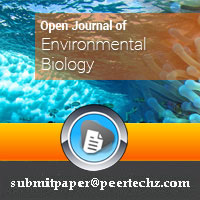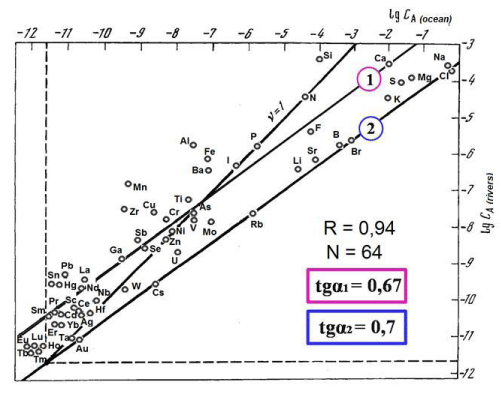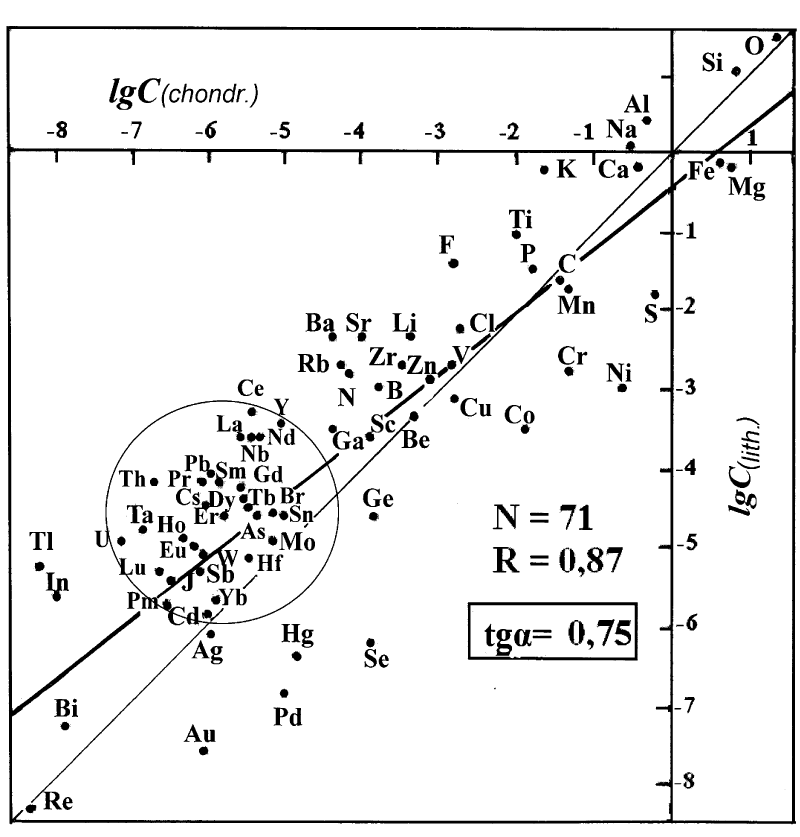Open Journal of Environmental Biology
On the role of living matter in the formation of the elemental composition of the biosphere
Korzh VD*
Cite this as
Korzh VD (2021) On the role of living matter in the formation of the elemental composition of the biosphere. Open J Environ Biol 6(1): 001-005. DOI: 10.17352/ojeb.000019The author develops the concept according to which the totality of all living organisms - "living matter" has the ability to purposefully influence the formation and functioning of the habitat on a global scale. This work is devoted to the study of the role of living matter in the formation of the elemental compositions of the hydrosphere and solid cover of the Earth. We have studied the dynamics of the global process of transfer of chemical elements in the ocean-atmosphere-continent-ocean system. Living matter is an active participant in this process. As a result of metabolic processes, living matter constantly creates and constantly maintains an increased concentration of trace elements in its environment. The biocenosis of the hydrosphere initiates increasing of the soluble forms of microelements in its habitat. The terrestrial biocenosis purposefully converts soluble forms of trace elements into insoluble forms to create favorable living conditions, in other words, acts in the opposite direction. The nonlinear laws of the processes of redistribution of average elemental compositions in the biosphere between liquid and solid phases (hydrosphere-lithosphere system) have been established. We have established a universal constant of nonlinearity of these processes in the biosphere equal to 0.7.
Introduction
Biological evolution proceeded under the sign of the liberation of developing organisms from the power of random phenomena in the external environment [1]. At a certain stage in the evolution of living matter - the totality of all living organisms, it became possible to basically implement liberation from the instability of the external environment. Back in the eighteenth century J.-B. Lamarck argued and tried to prove that all substances located on the surface of the globe and forming its crust were formed due to the activity of living organisms. In his work, the author proceeds from the concept of the biosphere developed by Academician Vernadsky. "The biosphere includes the terrestrial troposphere, oceans and a thin film in continental regions, extending to a depth of at least three kilometers ... The biosphere is defined as an area of life ... The substance that makes up the biosphere is significantly heterogeneous, and we distinguish between inert and living matter. Inert matter sharply prevails in mass and volume. There is a continuous migration of atoms from the inert matter of the biosphere to living matter and back" [2]. Considering the biosphere as a self-reproducing system, Academician V.I. Vernadsky noted that it’s functioning is conditioned by the existence of living matter in it - a set of living organisms living in it [2-4,5]. The first work of Vernadsky on this topic was published in French [3]. At present, Vernadsky's ideas are available to English-speaking researchers after the translation of his main work into English [5]. The well-known historian of science, researcher of Vernadsky's work G.P. Aksenov wrote that the new science of biogeochemistry leads to the understanding that "living matter" is the same part of nature as matter and energy, in relation to which no one asks "when and how they occurred". Their laws are not a consequence of their origin, but simply exist now and always [6]. We find convincing proofs of the formation of a biogeochemical environment by living matter in accordance with their needs in the work V.V. Kovalsky. "The organism and the environment, in particular the geochemical, are so dependent phenomena in the biosphere that it is impossible to consider separately the evolution of life and the evolution of the environment. This is a single system in which, in the processes of its existence, characteristic adaptations of organisms to the environment are developed, which are included in the number of phenotypic reactions that enrich the system life-environment. In this system, in relation to the geochemical factors of the environment, deep metabolic connections are established. An example is the release of organic substances into the soil environment, which give coordination compounds with the chemical elements of the environment outside the body, in which chemical elements (metals, microelements) acquire activity in processes of penetration through cell membranes and in subsequent transformations in the links of the biogenic cycle" [7]. The works of Kovalski’s convincingly indicate that living organisms not only adapt to the environment, as is well known since Darwin's time, but actively influence the chemical composition and state of aggregation of the habitat in accordance with their biogeochemical needs.
Method
We consider the elemental composition of biosphere as a system, possessing its specific organization level and emergence characteristics, i.e. an irreducibility of the system features to a number of properties of its consistent elements. When passing through the living material, the inert matter changes towards an increase in its order level and formation of a new structure. Interaction of the elements within the system has a particular role. Hence, the used methodology suggests some subordination of the system elements to the general laws of the system evolution.
The scourge of all scientific fields that study complex systems consisting of a large number of interacting parts is the abundance of information that needs to be processed to obtain a detailed description of the system. In order to reduce the amount of information to any acceptable size, they resort to the so-called information compression, as a rule, accompanied by its partial loss.
For example, instead of tracking the trajectories of gas particles in the kinetic theory of gases they go to the averaged characteristics e.g. use the pressure of the gas. The synergetic approach compresses information without any loss information-by switching from variables or state parameters to order parameters based on the principle of subordination, and the order parameter in turn are function of state parameters (circular causality principle). Order parameters play a dominant role in the concept of synergy. They “subordinate” separate parts, i.e. determine the behavior of these parts. The relationship between order parameters and individual parts of the system is called the subordination principle [8,9]. Successful determination of the parameters of the order usually leads to the discovery of the laws of life of a complex system. In our work, the mean concentrations of chemical elements in certain parts of the biosphere, expressed in g-mol/l (Table 1) and g-mol/kg, (Table 2) were chosen as order parameters.
Results and discussion
Figure 1 schematically shows the processes of transport of water and sea salts in the ocean – atmosphere – continent – ocean system. Evaporation and splashing of sea water is accompanied by the transfer of sea salts into the atmosphere. These salts come to land with rainwater and return to the ocean with river runoff. Sea salts enter the atmosphere with altered concentration ratios. Salts with a lower concentration are more mobile and migrate with greater intensity in the ocean – atmosphere – land – ocean cycle [2,8,10-16]. Hundreds of millions of tons of salts are annually involved in this process [10,16]. On the surface of the ocean, numerous processes of processing of inert matter by "living matter" take place. The power of the biogenic process is evidenced by the fact that about 100 billion tons/year of plankton dry matter is produced on the surface of the oceans and seas. The most important type of activity of the "living matter" of the hydrosphere is the change in the forms and concentrations of most of the elements in the water in the form of solutions. Similar processes take place at the river-sea barrier [8,9].
In order not to get lost in the endless complexity of biochemical processes, leading to the formation of stable elemental compositions of individual parts of the hydrosphere, we use the concepts "input” and “output". We regard the ocean as a complex system where transformations of the material that is received through a geochemical barrier “river - sea” (the input) provide average elemental composition of the ocean (the output) [11-16].
Figure 2 shows a graph of the relationship (in logarithmic form) between the average concentrations of elements in the world river flow and the World оcean build on the basis of reliable factual material [17,18]. The quantity of the studied elements is equal to 64, the correlation coefficient is equal to 0.94. The line corresponding to the equation as obtained by the linear regression method makes up angle of 34oc with the abscissa axis, tg α = 0.67. The fact that all the elements are located on one side of the line (or on the line precisely), forming an angle of tangent equal to 0.70 with the abscissa axis, also deserves attention [11,14].
The actual equality of the tangent for the line inclination angle as obtained by the linear regression method and the tangent ratio for the line reflecting the pattern of material transformation and migration in the barrier “ocean – atmosphere” (Figure 2), indicates the equality of constants for nonlinearity of the average elemental compositions redistribution processes as occurring between the dissolved and solid phases in absolutely different geochemical barriers “ocean - atmosphere” and “river - sea” [11,12-16]. The basic generalities of geochemical barriers are places, where life is concentrated. The deficiency of concentration of chemical elements is overcome by the purposeful work of "living matter", which, acting in concert as an integrity system, turns chemical elements from insoluble to soluble in the hydrosphere and from soluble to insoluble when the environment is soil.
The process of formation of the elemental composition of the soil cover of the Earth, in which living matter plays an active role, has been studied in detail and presented in the work [15]. The total amount of sea salt coming from the ocean surface through the atmosphere to the continents is about 108 tons/year [11,15]. The power of the flow of cosmic matter onto the Earth's surface in the form of highly dispersed particles of stone meteorites (chondrites) is consistently and close to this order of magnitude. A comparison of the average elemental compositions of the soil cover of the Earth and stony meteorites is shown in Figure 3. Data on the content of chemical elements in the main types of rocks of the earth's crust and in stony meteorites [1] are the basis for our constructions. The graphic of the in Figure 3 provides determination of the following groups of elements: Cmet > Clith (contains only 11 elements), Cmet ~ Clith (18 elements) and Cmet < Clith (42 elements) [19-21].
The correlation coefficient between logarithmically expressed element concentrations for the 71 studied chemical elements in proto planetary material and in the lithosphere is equal to 0.87. The tangent for the regression line inclination is equal to 0.75. This tangent numerical value is a quantitative estimation of the nonlinearity factor for the elemental composition general evolution within the system “proto lithosphere - living material - biosphere”.
Processing of inert matter on the surface of the Earth in which living matter plays an active role, leads to a general relative raise of chemical element concentrations in the solid phase according as the element prevalence in the environment drops. Therefore, convert of the chemical elements from more soluble compounds to some less soluble ones is a common and specific reaction of the "living matter" to the deficiency in their concentrations in the habitat.
Conclusion
Our research has shown that a set of living organisms - living matter, as an integral self-organizing system, has the ability to harmonize biogeochemical processes in order to create and constantly maintain optimal living conditions for the entire set of living organisms. The present technocratic civilization is destroying this property of living matter with increasing speed. We are developing the concept of the harmonious integrity of the biosphere (the concept of biosphere homeostasis). The stability of biogeochemical and other processes on the Earth's surface is completely determined by the coordinated, purposeful activity of living matter [12-16]. This process running in various natural systems has practically the same parameter of nonlinearity (v) approximately equal to 0.7 (proto lithosphere – “living matter” - lithosphere (v = 0.75); river – “living matter” – ocean (v = 0.67); ocean – “living matter” – atmosphere (v = 0.7). For the contemporary factual level of knowledge these differences estimations of nonlinearity indices are practically negligible. Hence, it is for the first time that the existence of a universal constant of nonlinearity of elemental composition evolution in the biosphere has been proved and its quantitative evaluation has been made. The nonlinearity index of biogeochemical processes obtained by the author is a universal constant that reflects the law of biogenic redistribution of chemical elements in the biosphere during its evolution. The universal constant of nonlinearity of the processes of formation of the elemental composition of the biosphere (equal to 0.7) established by us should be accepted as an ecological standard, violation of which is unacceptable.
I am grateful to Professor V.V. Ermakov without whose support my work was impossible to carry out. I am also grateful to Dr. E.M. Korobova for effective help.
- Volkenstein MV (1978) General biophysics. Moscow: Nauka 590.
- Vernadsky VI (1994) Living Matter and Biosphere. Moscow, Nauka 672.
- Vernadsky VI (1925) Sur la mate`re vivante dance la biosphere/ C.R. Acad. Sci Paris 120: 2079-2081.
- Vernadsky VI (1977) Reflections of a naturalist. Scientific thought as a planetary phenomenon. M, Nauka 191.
- Vernadsky Vladimir I (1977) The Biosphere. N.Y. Copernicus. Springer Verlag 192.
- Aksenov GP (2018) Vernadsky’s paradigm. Moscow: GEOKCHI RAS. 147.
- Kovalsky VV (1982) Geochemical environment and life. Moscow: Nauka 78.
- Knyazeva H (1999) The Synergetic Principles of Nonlinear Thinking. World Futures 54: 163-181. Link: https://bit.ly/3m3cjv5
- Korzh VD (2003) VI Vernadsky and the problem of the evolution of the elemental composition of the Biosphere (synergetic approach). In V.I.Vernadskyin a contemporary context. Moscow: Noosphere 121-133.
- Korzh VD (1984) Ocean as a source of atmospheric iodine. Athmos Environ 18: 2707-3710. Link: https://bit.ly/31rEB8U
- Korzh VD (1991) Geochemistry of the Elemental Composition of the Hydrosphere. Moscow “Nauka” 243.
- Korzh V (2009) Specificity of formation of the biosphere elemental composition. J Ecologica 16: 33–37.
- Korzh VD (2013) The General Laws of Chemical Elements Composition Dynamics in the Hydrosphere. Proceedings of the International Conference European Geosciences Union General Assembly 2013; Vienna, Austria 15: EGU2013-5989. Link: https://bit.ly/3rsKSM8
- Korzh VD (2017) Biosphere. The formation of elemental compositions of the hydrosphere and lithosphere. Saar-brucken: Lambert Academic Publishing 63.
- Korzh VD (2020) Transfer of trace elements in the ocean-atmosphere-continent system as a factor in the formation of the elemental composition of the Earth’s soil cover. Environmental Geochemistry and Health 42: 4399-4405. Link: https://bit.ly/3u3HTvD
- Korzh VD (2020) Non-linear character of redistribution of chemical elements in the biosphere components as a result of the living matter activity. Proceedings of the International Conference European Geosciences General Assembly, Vienna, Austria. Link: https://bit.ly/3dfLxfb
- Bruland KW (1983) Trace Elements in Sea-water. Chemical Oceanography. London: Academic Press 8: 157-220.
- Martin JM, Meybeck M (1979) Elemental mass-balance of material carried by major world rivers. Mar Chem 7: 173 - 206. Link: https://bit.ly/3tVVqoU
- Ermakov VV, Karpova EA, Korzh VD, Ostroumov SA (2012) Innovative aspects of biogeochemistry. M .: Izd. GEOKHI RAS 340.
- Korzh VD (1974) Some general laws governing the turnover of substance within the ocean-atmosphere-continent-ocean cycle. Journal of Research Atmosphere 8: 653-660. Link: https://bit.ly/3fqAeDg
- Vinogradov AP (1962) Average content of chemical elements in the main types of magmatic rocks of the Earth's crust. Geokhimiya, 7: 555-571. (in Russian).

Article Alerts
Subscribe to our articles alerts and stay tuned.
 This work is licensed under a Creative Commons Attribution 4.0 International License.
This work is licensed under a Creative Commons Attribution 4.0 International License.



 Save to Mendeley
Save to Mendeley
